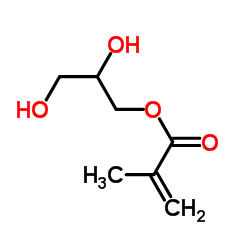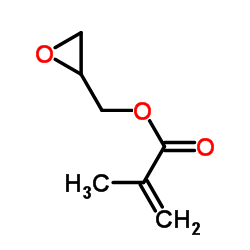5919-74-4
| 中文名 | 2-甲基-2-丙烯酸-2,3-二羟基丙酯 |
|---|---|
| 英文名 | 2,3-dihydroxypropyl methacrylate |
| 中文别名 | 2,3-二羟基甲基丙烯酸丙酯 |
| 英文别名 |
glycerol methacrylate
Glycerin 1-methacrylate Glyceryl monomethacrylate 2-Methyl-2-propenoic acid, 2,3-dihydroxypropyl ester GLYCERYL MONO-METHACRYLATE 2,3-dihydroxypropylmethacrylate Glycerol 1-methacrylate 2,3-Dihydroxypropyl methacrylate glycerol monomethacrylate Glycerylmethacrylate Methacrylic acid 2,3-dihydroxypropyl 2,3-Dihydroxypropylmethacrylat 1-glycerol monomethacrylate 2-Propenoic acid, 2-methyl-, 2,3-dihydroxypropyl ester Methacrylic acid 2,3-dihydroxypropyl ester |
| 密度 | 1.2±0.1 g/cm3 |
|---|---|
| 沸点 | 310.3±32.0 °C at 760 mmHg |
| 分子式 | C7H12O4 |
| 分子量 | 160.168 |
| 闪点 | 127.3±18.6 °C |
| 精确质量 | 160.073563 |
| PSA | 66.76000 |
| LogP | -0.12 |
| 蒸汽压 | 0.0±1.5 mmHg at 25°C |
| 折射率 | 1.476 |
| 储存条件 | 2-8°C,干燥,密封 |
Synonym:Glycerine-1-Methacrylate; 2-Methyl-2-Propenoic Acid; 2,3 Dihydroxypropyl Ester Section 2 - COMPOSITION, INFORMATION ON INGREDIENTS
Risk Phrases: 36/38 43 Section 3 - HAZARDS IDENTIFICATION EMERGENCY OVERVIEW
Irritating to eyes and skin. May cause sensitization by skin contact.The toxicological properties of this material have not been fully investigated. Potential Health Effects Eye: Causes eye irritation. May cause chemical conjunctivitis. Skin: Causes skin irritation. May cause skin sensitization, an allergic reaction, which becomes evident upon re-exposure to this material. Ingestion: May cause gastrointestinal irritation with nausea, vomiting and diarrhea. The toxicological properties of this substance have not been fully investigated. Inhalation: May cause respiratory tract irritation. The toxicological properties of this substance have not been fully investigated. Chronic: Effects may be delayed. May cause allergic skin reaction in some individuals. Section 4 - FIRST AID MEASURES Eyes: Immediately flush eyes with plenty of water for at least 15 minutes, occasionally lifting the upper and lower eyelids. Get medical aid. Skin: Get medical aid. Flush skin with plenty of water for at least 15 minutes while removing contaminated clothing and shoes. Wash clothing before reuse. Ingestion: Never give anything by mouth to an unconscious person. Get medical aid. Do NOT induce vomiting. If conscious and alert, rinse mouth and drink 2-4 cupfuls of milk or water. Inhalation: Remove from exposure and move to fresh air immediately. If not breathing, give artificial respiration. If breathing is difficult, give oxygen. Get medical aid. Do NOT use mouth-to-mouth resuscitation. Notes to Physician: Treat symptomatically and supportively. Section 5 - FIRE FIGHTING MEASURES General Information: As in any fire, wear a self-contained breathing apparatus in pressure-demand, MSHA/NIOSH (approved or equivalent), and full protective gear. During a fire, irritating and highly toxic gases may be generated by thermal decomposition or combustion. Vapors may be heavier than air. They can spread along the ground and collect in low or confined areas. Runoff from fire control or dilution water may cause pollution. Extinguishing Media: Use water spray, dry chemical, carbon dioxide, or appropriate foam. Section 6 - ACCIDENTAL RELEASE MEASURES General Information: Use proper personal protective equipment as indicated in Section 8. Spills/Leaks: Absorb spill with inert material (e.g. vermiculite, sand or earth), then place in suitable container. Avoid runoff into storm sewers and ditches which lead to waterways. Clean up spills immediately, observing precautions in the Protective Equipment section. Provide ventilation. Section 7 - HANDLING and STORAGE Handling: Wash thoroughly after handling. Use with adequate ventilation. Avoid contact with eyes, skin, and clothing. Keep container tightly closed. Avoid ingestion and inhalation. Wash clothing before reuse. Storage: Store in a tightly closed container. Store in a cool, dry, well-ventilated area away from incompatible substances. Section 8 - EXPOSURE CONTROLS, PERSONAL PROTECTION Engineering Controls: Facilities storing or utilizing this material should be equipped with an eyewash facility and a safety shower. Use adequate ventilation to keep airborne concentrations low. Exposure Limits CAS# 5919-74-4: Personal Protective Equipment Eyes: Wear appropriate protective eyeglasses or chemical safety goggles as described by OSHA's eye and face protection regulations in 29 CFR 1910.133 or European Standard EN166. Skin: Wear appropriate protective gloves to prevent skin exposure. Clothing: Wear appropriate protective clothing to prevent skin exposure. Respirators: Follow the OSHA respirator regulations found in 29 CFR 1910.134 or European Standard EN 149. Use a NIOSH/MSHA or European Standard EN 149 approved respirator if exposure limits are exceeded or if irritation or other symptoms are experienced. Section 9 - PHYSICAL AND CHEMICAL PROPERTIES Physical State: Liquid Color: clear brown Odor: Not available. pH: Not available. Vapor Pressure: Not available. Viscosity: Not available. Boiling Point: 140 deg C Freezing/Melting Point: Not available. Autoignition Temperature: Not available. Flash Point: Not available. Explosion Limits, lower: Not available. Explosion Limits, upper: Not available. Decomposition Temperature: Solubility in water: Specific Gravity/Density: Molecular Formula: C7H12O4 Molecular Weight: 160.0816 Section 10 - STABILITY AND REACTIVITY Chemical Stability: Stable at room temperature in closed containers under normal storage and handling conditions. Conditions to Avoid: Incompatible materials, excess heat. Incompatibilities with Other Materials: Strong oxidizing agents. Hazardous Decomposition Products: Irritating and toxic fumes and gases, oxides of carbon. Hazardous Polymerization: Will not occur. Section 11 - TOXICOLOGICAL INFORMATION RTECS#: CAS# 5919-74-4 unlisted. LD50/LC50: Not available. Carcinogenicity: Glycerol Methacrylate - Not listed by ACGIH, IARC, or NTP. Section 12 - ECOLOGICAL INFORMATION Section 13 - DISPOSAL CONSIDERATIONS Products which are considered hazardous for supply are classified as Special Waste and the disposal of such chemicals is covered by regulations which may vary according to location. Contact a specialist disposal company or the local waste regulator for advice. Empty containers must be decontaminated before returning for recycling. Section 14 - TRANSPORT INFORMATION IATA Not regulated as a hazardous material. IMO Not regulated as a hazardous material. RID/ADR Not regulated as a hazardous material. Section 15 - REGULATORY INFORMATION European/International Regulations European Labeling in Accordance with EC Directives Hazard Symbols: XN Risk Phrases: R 36/38 Irritating to eyes and skin. R 43 May cause sensitization by skin contact. Safety Phrases: S 26 In case of contact with eyes, rinse immediately with plenty of water and seek medical advice. S 28 After contact with skin, wash immediately with... WGK (Water Danger/Protection) CAS# 5919-74-4: No information available. Canada CAS# 5919-74-4 is listed on Canada's NDSL List. CAS# 5919-74-4 is not listed on Canada's Ingredient Disclosure List. US FEDERAL TSCA CAS# 5919-74-4 is listed on the TSCA inventory. SECTION 16 - ADDITIONAL INFORMATION N/A |
| 海关编码 | 2916140000 |
|---|---|
| 中文概述 | 2916140000. 甲基丙烯酸酯. 增值税率:17.0%. 退税率:13.0%. 监管条件:无. 最惠国关税:6.5%. 普通关税:80.0% |
| 申报要素 | 品名, 成分含量, 用途, 丙烯酸、丙烯酸盐或酯应报明包装 |
| Summary | 2916140000. other esters of methacrylic acid. VAT:17.0%. Tax rebate rate:13.0%. . MFN tariff:6.5%. General tariff:80.0% |






